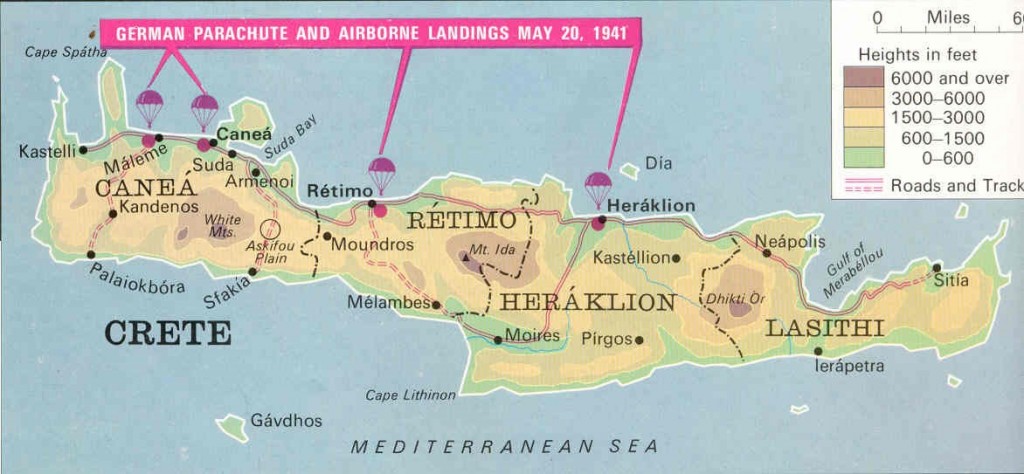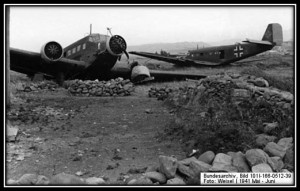Last Spring I did a presentation to my local Military History group about the Crete Campaign of 1941 and figured that since I now have the time I would put something up here about it as well because I find the whole campaign to be a comedy of errors by both sides in this misguided, ill-conceived, and poorly executed excuse for a battle. First, we should examine the strategic situation in May of 1941.
In May 1941 England had been run out of Greece with its tail between its legs and was using Crete as both a staging ground for evacuation and they were hoping like hell they could hold it and stop the Mediterranean, or at least the eastern part from turning into a German Lake. For their part, Germany did not know what to do. They were in the last stages of planning the attack on Stalin’s Russia set to commence in June but in the meantime they had all these troops hanging out in Greece with nothing to do. The possession of Crete would have conferred no strategic or even operational advantage to the Germans as the British still controlled Malta and the British navy still controlled the waters of the Mediterranean Sea.
What the Germans decided to do was use their parachute troops to take the strategically irrelevant island of Crete upon which the Greek king was in hiding. To do this the Germans had 29,000 troops in the XI Fliegerkorps consisting of the 7th Flieger (parachute)Division, 5th Mountain Infantry Division, and Supporting Air Forces along with 3,000 near worthless Italian troops from the 9th Italian Infantry Division. To counter them the British 25,000 troops consisting of the New Zealand 2nd Division, Australian 19th Brigade, British 14th Brigade, and a hodgepodge of various units evacuated from the Greek mainland and in differing states of combat effectiveness.
The plan the Germans came up with was actually fairly straightforward and would have worked well if things had gone according to plan. However, like most military operations this one started differing from the plan as soon the plan was put into execution. What the Germans wanted to do was air-land several battalions the morning of May 20th to capture and secure the airfields of Maleme, Canea, Retimo, and Heraklion on the north coast of Crete. Once the initial airfields had been captured additional forces would be ferried in by land and sea to reinforce the assault echelon and start to assault and conquer the rest of the island. The asdsault was planned to go in on the morning of May 20th and that the attack started that day is about the only thing that went according to plan for the German paratroops during the entirety of the campaign to capture Crete.

Day 1 – May 20
The initial German landings were no different than any other mass attack ever attempted. In short they were a disaster. Some units hit their DZ, some units missed it, and some units dropped among the defenders. Where German paratroops dropped among defenders they suffered almost 100% casualties. Initial casualties among the assaulting units were high, averaging 25%. One of the things that hampered the German paratroops from achieving their first day objectives is that the troops dropped with only sidearms at best. Their rifles and other heavier equipment was dropped with them in cargo containers that the troops had to both find and secure before they were fuly equipped. In practice this meant that most tropos who got their personal weapons took anywhere from 1-3 hours to do so and some Germans were reduced to scavenging weapons from the dead as cargo bundles missed the drop zones altogether.
Not all of the initial objectives were taken. In fact, none of the first days objectives were taken on the first day. The Germans had the most success at the Maleme airfield where the Germans managed to secure the western end of the airstrip and drive the British forces from the eastern end although they could not consolidate their hold on the entire airstrip as some NZ troops held the commanding heights to the south. The German commanders in Athens realized that Maleme was where they were having their most success and concentrated on reinforcing the troops assaulting Maleme while only providing resupply and minimal reinforcement to the other airheads.
Day 2 – May 21
During the night of 20-21 May the Germans attempted to send their first surface flotilla from the Greek mainland to Crete but it was forced to turn round and return to Greece after

being savaged by the British Force D of 3 light cruisers and 4 destroyers which managed to sink one German boat and caused the death of about 1/3 of the embarked soldiers and sailors. A Bright spot for the Germans was their continued air superiority over crete which allowed them to continue to send transport aircraft to the island to keep the assault going.
On the 21st the British tried and failed to recapture Maleme Airfield to deny it use to the Germans. They managed to reach the airfield but were thrown back when the rising sun let the Germans make use of their air superiority and pound the attacking Commonwealth units and force them to abandon their attack. The Germans made excellent use of their air superiority to harry and attack the British naval forces operating around Crete. They managed to keep the British out of the waters between the island and the mainland during daytime but were less successful at night.
Day 3 – May 22
During the night there was another unsuccessful German attempt at a surface convoy to Crete. Shortly after dawn the British once again attempted to regain the Maleme airfield but this stalled in the face of withering firepower from the by now prepared and somewhat resupplied Germans. The Germans were still managing to get a trickle of reinforcements into Maleme airfield while sacrificing some aircraft that landed along the beach at Maleme to bring in supplies and troops while evacuating wounded.
Days 4-8 – May 23-27
In the face of mounting German pressure and the failure to retake Maleme the British decided on retreat and evacuation. They thus ordered all their forces to disengage and start moving to the southern coast for evacuation. The Germans finally got Maleme airfield fully operational and managed to get surface convoys past the British fleet which retreated from the Cretan strait in the face of German airpower. On May 27 the Italians finally entered the battle by landing a brigade of the Italian 9th INF Div. unopposed at Sitia and moving to link up with the Germans. During the course of the battle the Germans managed to sink 9 ships including the battleships Orion, Fiji, Calcutta, and Gloucester.
Days 9-12 – May 28-31
The British successfully managed to do another partial Dunkirk and evacuate 16,000 of their 25,000 troops from the island. Troops they subsequently sent to Egypt and the Western desert. The British also managed to extract the King of Greece who had been near Maleme when the fighting started and had made his way on foot across the island to evacuation. By 31 May the battle was essentially over except for mopping up.
The cost of the battle was especially high. Afterwards the Germans never conducted another mass parachute assault in World War II.
I. German
i. Dead – 4,000
ii. Wounded – 3,000
iii. Total – 7,000
II. Commonwealth
i. Dead – 3,990
ii. Wounded – 2,750
iii. Captured – 17,090
iv. Total – 23,830

